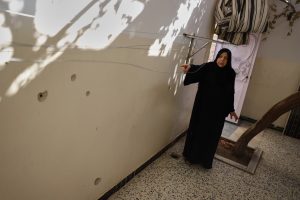CNA’s war-gaming for national defense: Weapon of the week

For much of what’s on display at defense exhibitions, it’s a lot like a museum. People can look, but they can’t touch, and that’s what makes our weapon of the week so interesting.
Nestled in the far corner of the convention center at this year’s Navy League Sea Air Space exhibition was a display that invited passers-by to stop, ask questions and roll the dice.
How does CNA plan war games?
Jeremy Sepinsky is the lead war gamer at the Center for Naval Analyses (CNA). He organizes and develops the skills of their war game design team. This group designs around 20 games each year, each created to explore specific customer needs.
“The number one question we always ask is, what are we trying to do with the game? What is the outcome?” Sepinsky said. “How is the game fitting into a research, analytic or educational portfolio? It’s not all about, ‘Hey, I’ve got this comeback position.’ It’s always about what we are trying to do at CNA. We design war games to fit into whatever problem space our sponsor is looking for.”
Once CNA’s wargamers determine their objectives, they analyze the game and consider what contingencies and concerns might evolve during play. Then, they set up a war game focused on that operation, ensuring it encourages players to explore “what if” scenarios.
“And we play through those ‘what if’ scenarios,” Sepinsky explained. “Our data collectors record what happened and why. They consider contingency planning exercises that need to be addressed. We write a report about these findings, which helps sponsors understand what they may need to think through in the whole problem space.”
Why are war games important?
Sepinsky says the war games enable participants to engage in realistic simulations, sparking discussions about decision-making, operational planning and contingency scenarios.
“We hope our sponsors take the output of the game and use it to decide where they need to focus their efforts,” Sepinsky said. “This informs their decision-making.”
Sepinsky estimates he has designed more than 60 war games over the course of a decade at CNA. Every year, he and a team of 12 execute as many as 20 of them for their customers. He points out that war games are just one piece of any eventual solution.
“I’ve been talking a lot about analytic war games, but they provide an immersive educational experience as well,” Sepinsky noted. “They need to be emphasized from an analytic perspective with a real analytic plan and program. From an educational perspective, they need a real curriculum. This way, they aren’t standing alone, and you get reinforcement learning and analysis through all other methods that support the cycle of research. This feedback loop between exercises, analysis and war games helps understand the full spectrum of conflict.”
Sepinsky also emphasized that the outcomes of their war games usually have long-term implications rather than immediate impacts. They shouldn’t be used for quick decisions or major strategy changes. Instead, they help identify key issues for deeper analysis.
Access the full Weapons and Warfare episode here.
Access all Weapons and Warfare podcast episodes here.





